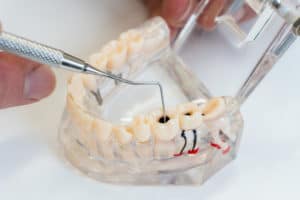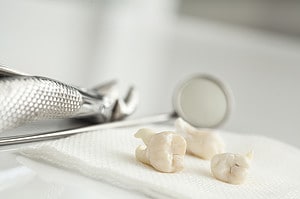On average, approximately 3.1 million Australians have at least one missing tooth. Dental bridges are a popular solution for replacing missing teeth in Australia.
This article will explore the different types of bridges, the procedure for getting a bridge, how long it takes to make a bridge, the benefits of getting a bridge, and alternative solutions.
What is a Dental Bridge?
A dental bridge is a prosthetic device used to replace missing teeth. It is a cost-effective solution to missing teeth that can be used in place of dental implants. A bridge is typically constructed from two or more dental crowns for the teeth on either side of the gap, with a false tooth in between. The crowns are fitted over the existing teeth and hold the false tooth in place. In some cases, a dental implant can be used to support the bridge instead of crowns.
The procedure for getting a dental bridge usually takes two visits. During the first visit, the dentist will prepare the teeth around the gap by trimming and reshaping them to make room for the crowns. They will then make an impression of the teeth and send it off to a lab where the bridge will be created. On the second visit, the bridge will be fitted and secured onto the teeth with dental cement or porcelain wings.
Dental bridges come in several types, such as conventional, cantilever, implant-supported, and resin-bonded. The type of bridge chosen will depend on the location of the missing tooth, the health of the surrounding teeth, and the patient’s budget. On average, getting a dental bridge takes about two weeks.
What Are the Different Types of Bridges?
Various types of bridges are available for the replacement of missing teeth. Dental bridges are one of the most popular options. A permanent bridge, also known as a fixed Bridge, consists of two abutment teeth connected by one or more artificial teeth. Abutment teeth are teeth that support the bridge.
Temporary bridges are designed to be a short-term solution and are often made of acrylic or metal. Traditional Bridges, which are the most common type, use a pontic (artificial tooth) supported by two abutment teeth.
Cantilever bridges are used when only abutment teeth are on one side of the bridge. Adjacent teeth, which are the teeth next to the missing tooth, are used to support the bridge.
All types of dental bridges require healthy gum and bone tissue. When there is gum disease or tooth decay present, a dentist may need to perform a gum graft or root canal to ensure the bridge will remain stable.
What is the Procedure for Getting a Bridge?
The procedure for obtaining a bridge typically involves several steps.
First, a comprehensive dental exam is completed to ensure that the patient’s natural teeth, gums, and jawbone are healthy enough to support a bridge.
Next, the missing teeth are prepared for the bridge. This may include professional cleanings, root canals, and other procedures to prepare the area for the bridge.
After the area is prepared, a resin-bonded bridge or a porcelain framework is made to fit the patient’s mouth. This framework is then attached to the natural teeth, creating a permanent tooth.
Lastly, the bridge is adjusted and polished to match the patient’s bite and natural teeth.
Throughout the entire dental bridge process, it is important for the patient to maintain good oral hygiene, including brushing and flossing daily and regular professional cleanings.
With proper care, a custom bridge can last for years.
How Long Does it Take to Make a Dental Bridge?
Construction of a custom bridge typically requires multiple visits to the dentist, as a healthy set of teeth is essential to the dental bridge procedure. With proper care and dental hygiene, a bridge can provide a strong, reliable alternative to dentures and can easily last for many years.
The process of making a bridge begins with the dentist taking an impression of the teeth and surrounding area. This impression is then used to create a metal framework to hold the replacement teeth in place. Once the framework is ready, the dentist will permanently attach the bridge to the surrounding teeth. This is done with special dental cement, which ensures the bridge will stay in place.
Depending on the complexity of the bridge, the entire process can take anywhere from two to six weeks. The dentist should provide the patient with general guidelines for recovery time and regular visits for proper care and maintenance of the bridge.
With proper dental care, a bridge can provide a functional and aesthetically pleasing solution to missing teeth.
What Are the Benefits of Getting a Dental Bridge?
Replacement of missing teeth via a bridge can offer numerous advantages for patients. Dental bridges are custom-made false teeth that are used to fill the space left by missing teeth and are held in place by the teeth adjacent to the gap. There are several types of dental bridges, including traditional bridges, cantilever bridges, and implant-supported bridges.
Traditional bridges involve anchoring false teeth to two adjacent teeth to fill the gap, while cantilever bridges involve anchoring the false teeth to only one adjacent tooth. Implant-supported bridges involve implant-supported false teeth that are attached to titanium posts inserted into the jawbone.
Teeth bridges can restore a patient’s natural shape and appearance of the teeth and help to prevent teeth from shifting out of place. Bridges can also restore the ability to chew and speak normally and help to maintain good oral and dental health.
Getting a dental bridge usually requires two or more visits to the dentist. During the first visit, the dentist will examine the patient’s teeth and take impressions to create the bridge. During the second visit, the bridge will be fitted and adjusted to ensure a natural shape and comfortable fit. With proper care and maintenance, a bridge can last up to 10 years or more.
What are the Alternatives to a Dental Bridge?
Transitioning from the previously discussed benefits of a dental bridge, this section will explore alternative solutions for replacing a lost tooth. The dental bridge placement procedure is a popular choice among modern dentistry patients; however, certain alternatives may be more suitable depending on a person’s needs.
Types of bridges available include partial dentures and dental implants with an abutment. Partial dentures are often custom-made to mimic the lost tooth in terms of colour and size. These dentures are typically made of acrylic and metal and are removable for cleaning. They also help to maintain adequate spacing for proper chewing and speech.
Dental implants are generally favoured by those who are in good oral health but have lost a tooth due to injury or decay. This procedure involves inserting a titanium post into the jawbone to act as a replacement root. Over time, the jawbone heals around the post and allows for a secure abutment to attach an artificial tooth.
No matter which choice is made, it is important to maintain good oral hygiene habits. This includes brushing with a soft-bristled toothbrush twice a day, flossing at least once a day, and avoiding chewy or sticky foods. Following these habits can help to ensure a successful replacement of a lost tooth.
Key Takeaways
The dental bridge is an efficient way of replacing missing teeth. It is a versatile treatment option that can be tailored to the individual needs of the patient.
It typically takes two to three weeks for the bridge to be completed. On average, a bridge can last up to 15 years with regular maintenance.
The benefits of a dental bridge are numerous, with the most important being improved appearance, improved chewing ability, and improved speech. While there are alternative treatments, such as implants and dentures, a dental bridge is often the most cost-effective and convenient choice.
It is estimated that 70-90% of bridges remain functional after ten years, making it a reliable and long-term solution.
If you are in need of quality dental bridge services, look no further than Aspendale Gardens Dental Care. Our experienced and knowledgeable dentists in Aspendale will ensure that your bridge is fitted correctly and designed to last for many years. We take pride in our commitment to providing excellent dental care and excellent customer service to our patients. Visit us today at Aspendale Gardens, VIC and experience the difference that Aspendale Gardens Dental Cea can make in your quality of life.











